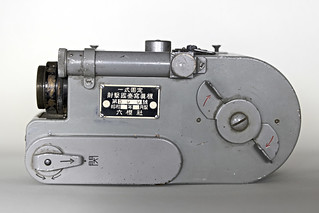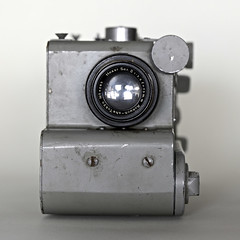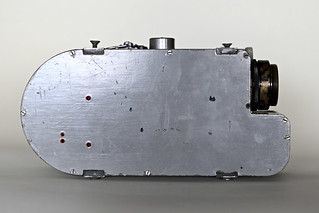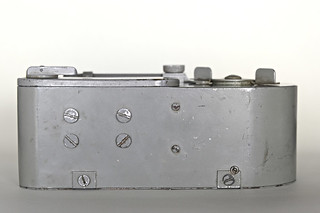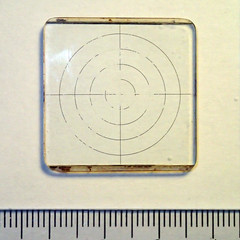Type 1 Fixed Target-checking Camera
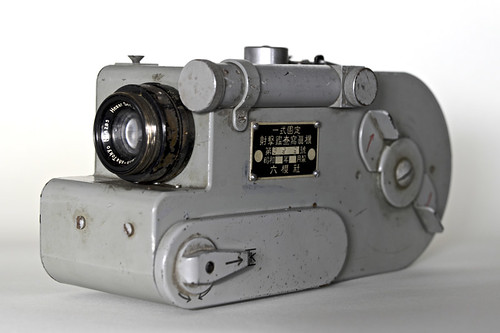
|
| Rokuoh Sha (六桜社) Type 1 Fixed Target-checking Camera with Hexar Ser II f/3.5 75mm image by Dirk HR Spennemann (Image rights) |
The Type 1 Fixed Target-checking Camera (一式固定射撃鑑査写真機) is an aerial camera developed by Rokuoh-sha (六桜社) for the Imperial Japanese Army (IJA) as a gun sight aiming point (GSAP) camera. Given its design, this camera would have been mounted in the starboard wing of fighter aircraft to verify the pilot's claims of enemy aircraft shot down. These cameras were synchronised with the machine gun of the fighter aircraft and operated when the pilot pressed the gun trigger. The spring-motor driven unit normally fired short bursts only and is in essence a hybrid between a motorised 35mm camera and a proper cine camera.
Description
The Type 1 Fixed Target-checking Camera takes 35mm film and was produced in two variants, first with a Hexar Ser II f/3.5 75mm[1] and later with an Optor f/3.5 75mm lens.[2][3]
Shutter release could either be manually via a release button on the top (protected from accidental triggering by a silver cylinder) or electrically via a three-pin connector (coupled to the machine gun trigger). The shutter speed of the camera is fixed (speed unknown at present); the Hexar lens has marked aperture f-stops from f/3.5 to f/8 (with audible click stops). The shutter seems to be a continually traveling (metal) curtain design with a fixed slot width. The optical path is redirected from the lens via a 45º mirror at right angles downwards towards the film plane. A 'focussing screen' is etched with cross hairs with four concentric circles. These are thus superimposed on each exposed frame.
The unit is a spring wound camera that takes cartridges loaded with short lengths (~1.5m) of perforated 35mm film. The film comes off the feed spool emulsion side out (up) and is wound onto the take-up spool emulsion side in. This suggests that the cartridges would have been loaded and unloaded in the dark(room). The top side of the magazine, facing the glass plate with the cross-hairs, has a dark slide is slid sideways when the cover of the magazine bay is closed tight.
Dimensions
197 x 87 x 97 mm; weight 3.3kg.
History
Based on the observed serial number data, the total number of units built is unlikely to exceed 2000.[4] This is confirmed by the U.S. Naval Technical Mission to Japan;[5] the same report also gives an indication of the start of production. Officially the IJA had ordered 200 units for 1941 (with additional orders placed for 1942 and 1943), but none were delivered. Production lagged well and truly behind. We can only speculate whether this had to do with the complexity of the mechanism (as opposed to the larger Type 89 machine gun camera). Be is as it may, the first batch of 218 units ran off the Rokuoh Sha production line in 1942, followed by 1,180 units in 1943. In 1945 production finally almost caught up with the total orders the IJA had placed, even though none had been ordered for 1944 and 1945(Table 1).
According to the U.S. Intelligence assessment, the total number of cameras manufactured was 1979. That number is a fraction of the total number of fighters built for the IJA in the same period (almost 17,000 aircraft combined). Either the Type 1 Fixed Gun Camera served only for training purposes for single seater fighters (whereas the Navy Type 89 machine gun camera served in two-seater aerial combat training) or it was designed only for a specific model of fighter. At current state of research that question cannot be answered definitively, but given the short lengths of film used, a use for training purposes is the more likely application (compare the 16mm GSAP used by the U.S. forces).
Table 1 Production volume of Rokuoh Sha/Konishiroku Type 1 Fixed Target-checking Camera for the period 1941-1945[5]
| Year | 1941 | 1942 | 1943 | 1944 | 1945 | Total |
| Ordered | 200 | 1180 | 800 | 0 | 0 | 2180 |
| Delivered | 0 | 218 | 1120 | 430 | 211 | 1979 |
|
|
| ||||||
|
|
| ||||||
|
Rokuoh Sha (六桜社) Type 1 Fixed Target-checking Camera with Hexar Ser II f/3.5 75mm | ||||||||
Notes
- ↑ The lens bezel states "Rokuoh Sha Tokyo" Photograhica Collection Dirk HR Spennemann
- ↑ Iwama, p.54 of Kurashikku Kamera Senka no.10.
- ↑ The lens bezel states "Konishiroku:
- ↑ On record are fitted with Hexar lens: s/n293, 599,132; with Optor lens: s/n1857.
- ↑ 5.0 5.1 Japanese Naval Photography. Compiled by Lt W.D.Hedden, USNR, with LtCdr G.Z.Dimitroff USNR and Lt(jg) W.A. Seymour, USNR. Intelligence Targets Japan (DNI) of 4 September 1945. Facicle A-1, Target A-39. U.S. Naval Technical Mission to Japan. December 1945. pp.8-9
